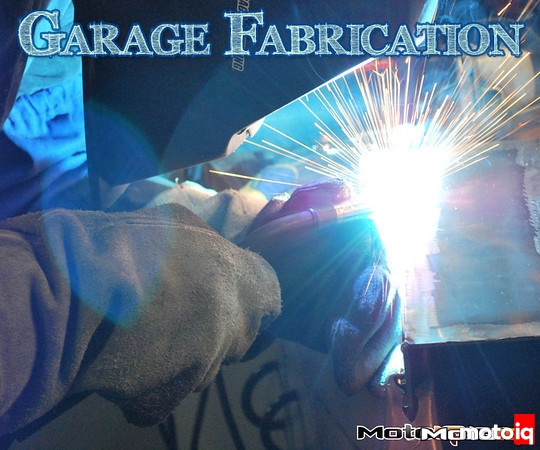,
Now that we've got our materials, tools and workspace in order, we're ready to weld, right? Not so fast. The most determinate factor in weld quality next to operator skill is cleanliness. Weld dirty metal, expect sooty, spattered welds with plenty of inclusions and porosity. All mild steel bought from metal supply places will come with a fine layer of oil to prevent corrosion. This oil will fight you the whole way through your project if you don't do something about it first. I usually use a mild soap-based degreaser and water if I can dry the part right away, or mineral spirits and a little heat (to evaporate any remaining solvents) if I can't. Never, EVER, use chlorinated break cleaner. Ever. Chlorinated brake cleaner, when combined with lots of heat and argon gas (also known as welding) can create the chemical warfare agent formerly known as phosgene. Phosgene is deadly in concentrations of as little as 4ppm, and should you survive the poisoning (there is no cure for its effects), emphysema and bronchitis are among its long term effects. Again: DO NOT CLEAN METAL WITH CHLORINATED BRAKE CLEANER!
Now that we've got the metal degreased and hopefully haven't died from inhaling a chemical warfare agent, the next step is to tackle the area to be welded. In case you haven't noticed, most mild steel you buy from metal supply places is a dull gray color instead of the shiny color we usually associate with steel. This dull gray color is visual evidence of surface oxides left over from the casting and stretching process (most mild steel flat stock is cast as a larger ingot then extruded a number of times to desired thickness). Since oxygen is the primary gas you are trying to displace with your argon shielding gas, it would be best to remove what is embedded into the metal you're about to weld. For this task, I use an angle grinder with a 60 grit flap disc. If you've been making do with regular grinding wheels, I highly recommend you pick a couple of these up as they'll change your life forever. Grind the metal until it looks nice and shiny, and make sure to grind to about two inches away from the expected weld joint. You will need to grind both sides, as if you've got everything set up right, your weld should penetrate all the way through the metal and you will introduce impurities into the back side of the weld.
 |
| Clean and prep the metal thoroughly before welding. Any impurities (whether oil or otherwise) will contaminate your weld. DO NOT USE CHLORINATED BRAKE CLEANER UNDER ANY CIRCUMSTANCES!!! |
Before you get started making the pretty blue lady dance, you need to make sure you're permanently fusing things together in an acceptable fashion. You could just hold it, tack weld it, pray, then check to see if it was somewhat in the right spot, but since I'm too lazy for this, I spend a little time actually using tools to make sure it's right the first time. The easiest way to ensure that you keep everything nice and perpendicular is to clamp a square in a bench vice so that it is held flat against your work bench (which is hopefully flat) then clamp the piece of steel that will be perpendicular to the work surface to the square. This allows you to not have to worry about holding the metal together (which is a major source of frustration) and also allows you to elevate the metal so that only the corners meet (called a full-open corner joint) instead of overlapping (half open or flush corner joint) – allowing you to weld into a valley and distribute the heat evenly between the two pieces instead of on a flat surface. Clamp the second piece of metal to the workbench so that it sits against the perpendicular piece.
 |
Jigging your metal prior to welding will save countless headaches and grinding of tack welds.
|
 |
| Once you've got your first two pieces tacked together and stable, your square and a simple welding magnet are usually sufficient to continue tacking additional pieces to your workpiece. |
If this is a grade and thickness of metal you've never welded before (or you didn't write down your settings for this grade/thickness/joint), it's time to get your welder set up to make sure you're not going to punch a hole straight through or glob a bunch of boogers on there. Since this is 1/8″ mild steel, it's going to be pretty forgiving of buffoonery with most welders you'd find at home, but you still don't want to have to fix mistakes on your actual workpiece. This is where the two 1″ wide scraps come into play. Set them up mostly similar to how you've set up your workpiece (I usually just do the hold, tack and bend to parallel method since this is just practice) and get your welder prepped.
Before you pull the trigger on the welder, you need to do some prep work to ensure consistent and solid welds, and there are a couple of tricks to make your life easier. The first is cutting the small piece of slag that remains after the last weld was performed. This piece of slag likely cooled after the gas was turned off, and therefore is likely to be a source of impurities. In addition, this bulb on the end can cause a lot of sputtering since you're adding mass to the wire to be burned. Second, you need to ensure the “stickout” length is correct. The stickout length is, literally, the amount of wire sticking out of the electrode tip. Too much stickout and you're going to end up with a bunch of popping and spitting machine gun fire when you pull the trigger. Too little stickout and you'll just burn up all the wire in an instant and probably fuse it to the tip, jamming the machine. Generally speaking, I cut it to about ½” in length with 0.023″ wire (pretty much all I use). If you're using thicker wire, you're going to need to trim this a little shorter.
 |
This little piece of slag leftover from the last weld will introduce impurities into your weld. Cut it off prior to every weld, even tack welds. A PITA, yes, but worth the effort. |


